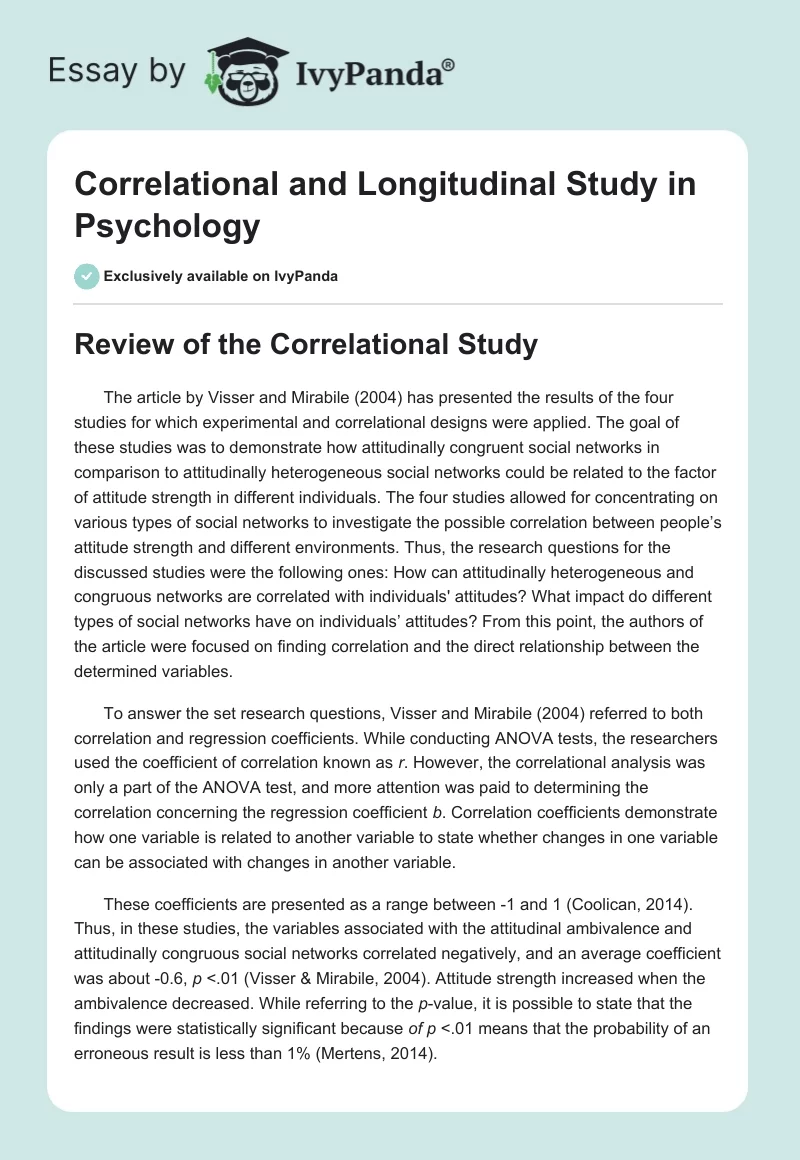Review of the Correlational Study
The article by Visser and Mirabile (2004) has presented the results of the four studies for which experimental and correlational designs were applied. The goal of these studies was to demonstrate how attitudinally congruent social networks in comparison to attitudinally heterogeneous social networks could be related to the factor of attitude strength in different individuals. The four studies allowed for concentrating on various types of social networks to investigate the possible correlation between people’s attitude strength and different environments. Thus, the research questions for the discussed studies were the following ones: How can attitudinally heterogeneous and congruous networks are correlated with individuals’ attitudes? What impact do different types of social networks have on individuals’ attitudes? From this point, the authors of the article were focused on finding correlation and the direct relationship between the determined variables.
To answer the set research questions, Visser and Mirabile (2004) referred to both correlation and regression coefficients. While conducting ANOVA tests, the researchers used the coefficient of correlation known as r. However, the correlational analysis was only a part of the ANOVA test, and more attention was paid to determining the correlation concerning the regression coefficient b. Correlation coefficients demonstrate how one variable is related to another variable to state whether changes in one variable can be associated with changes in another variable.
These coefficients are presented as a range between -1 and 1 (Coolican, 2014). Thus, in these studies, the variables associated with the attitudinal ambivalence and attitudinally congruous social networks correlated negatively, and an average coefficient was about -0.6, p <.01 (Visser & Mirabile, 2004). Attitude strength increased when the ambivalence decreased. While referring to the p-value, it is possible to state that the findings were statistically significant because of p <.01 means that the probability of an erroneous result is less than 1% (Mertens, 2014).
Research Question for the Longitudinal Study
The research question for a correlational longitudinal study on the topic of the role of college education and networking in receiving better or ‘dream’ jobs can be formulated the following way: What is the relationship between the 2017 college graduates’ use of networking and their chance to obtain high management positions in five years? To address the specifics of a longitudinal study, it is important to demonstrate that the project will be conducted during a certain period to reveal changes in tendencies related to the research topic (Coolican, 2014; Mertens, 2014). For this project, it is essential to show how college degrees and students’ participation in networking can potentially influence these students’ possibilities or perspectives to receive jobs that they want within the next five years.
For this study, it is possible to monitor changes in young persons’ positions during five years while focusing on the most significant personal data related to transitions and career development each year. The proposed research question is effective for a correlational study; therefore, the focus is on examining whether there is a positive or negative correlation between students’ interests in networking and received jobs (Coolican, 2014). From this point, the provided research question can be discussed as appropriate to narrow the study according to the proposed topic and address the project goals regarding the research design and methods.
References
Coolican, H. (2014). Research methods and statistics in psychology. New York, NY: Psychology Press.
Mertens, D. M. (2014). Research and evaluation in education and psychology: Integrating diversity with quantitative, qualitative, and mixed methods. Thousand Oaks, CA: Sage Publications.
Visser, P. S., & Mirabile, R. R. (2004). Attitudes in the social context: The impact of social network composition on individual-level attitude strength. Journal of Personality and Social Psychology, 87(6), 779-795.


